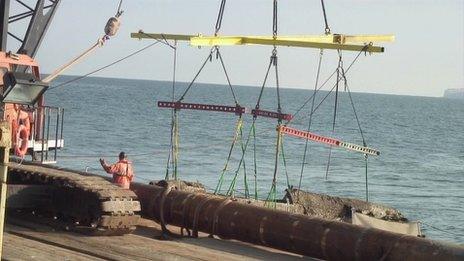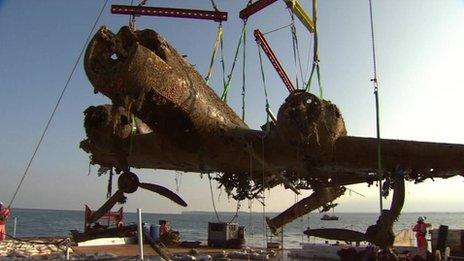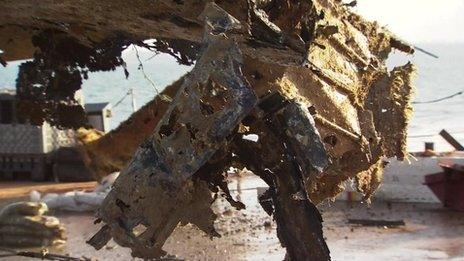WWII Dornier bomber raised from English Channel
- Published
Watch the moment the bomber was raised from the depths. Nick Higham reports
A German World War II bomber has been raised from the bottom of the English Channel.
The Dornier Do-17 aircraft was shot down off the Kent coast more than 70 years ago during the Battle of Britain.
Believed to be the only intact example of its kind in the world, it has lain in 50ft (15m) of water on the Goodwin Sands.
Attempts by the RAF Museum to salvage the relic had been hit by strong winds over the last few weeks.
The BBC's Nick Higham on board the salvage barge said the weather conditions for the hour-long operation were "near perfect" on Monday evening.
The salvage almost had to be postponed again when the rope from one of the salvage barge's four anchors got wrapped around its propeller, but the crew were able to free it in time to take advantage of the tidal conditions, our correspondent said.
The aircraft was badly corroded, the fuselage twisted and held in place only by a strut inserted by the salvage team. The engines had come adrift and will not be raised until Tuesday, he added.
The Dornier will be restored at a site in Shropshire before eventually going on display at the RAF Museum in Hendon, north London.
Museum spokesman Ajay Srivastava said: "It has been lifted and is now safely on the barge and in one piece.
"The operation has been an absolute success, the aircraft looks great and I believe it will be towed into port tomorrow morning."
Originally designed as a fast reconnaissance aircraf, the Dornier had been converted by the Luftwaffe in the mid-1930s into a medium bomber.
The aircraft was a mainstay of the German bomber fleets during the Battle of Britain in 1940. The wreck is believed to be aircraft call-sign 5K-AR, shot down on 26 August that year at the height of the battle.
Two of the four crew members died and were buried elsewhere, and two - including the pilot - survived to become prisoners of war.
The existence of the aircraft at Goodwin Sands became known when it was spotted by divers in 2008 lying on a chalk bed with a small debris field around it.
Sonar scans by the RAF Museum, Wessex Archaeology and the Port of London Authority then confirmed the identity of the aircraft.
A grant of more than £345,000 from the National Heritage Memorial Fund allowed the salvage project to start.
The plan was three years in the making and involved divers attaching lifting equipment to what are believed to be the strongest parts of the Dornier's frame and raising it whole, in a single lift.
The original plan to build an aluminium frame or cradle around the fragile wreck was abandoned after it became clear it would take too long and send the £600,000 project way over budget.
A two-year restoration will now take place at the RAF Museum's site in Cosford, Shropshire.
Experts plan to spray the wings and fuselage with water and a combination of citric acid and sodium hydroxide in an attempt to halt corrosion.

The World War II Dornier 17 bomber was raised from the English Channel earlier.

Experts believe the plane is the last remaining Dornier bomber in existence

Parts of the fragile wreck of the plane, which lay in the sea for 70 years, are missing
- Published8 May 2013
- Published10 June 2013
- Published10 June 2013
- Published6 June 2013
- Published3 June 2013